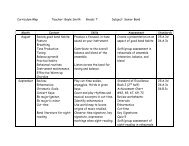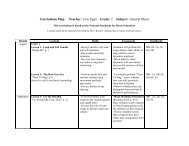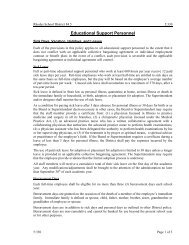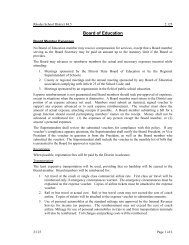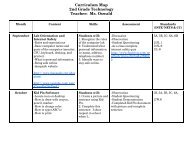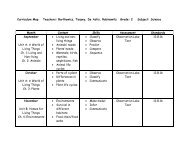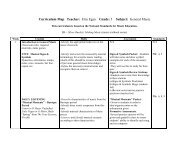Vocal Music Grade 1
Vocal Music Grade 1
Vocal Music Grade 1
- No tags were found...
You also want an ePaper? Increase the reach of your titles
YUMPU automatically turns print PDFs into web optimized ePapers that Google loves.
Septembercont.…Lesson 5: Same Phrases – Echoes“Down by the Bay” p. 18-Sing the “echo” part in asong-Identify the form of a song-Describe how rhymingwords are used in songlyrics-Sing with the performanceCD; observe whetherchildren know when to singthe echo on their own-Ask students to volunteerappropriate rhyming wordsfor songNS: 1A, 6A, 6C,8BLesson 6: Same Phrases – Call &Response“Mashed Potatoes” p. 20Mashed Potatoes, p. 21Zydeco Dancing (recording), p. 20-Sing the call-and-responseparts in a speech piece-Describe the feeling createdby a Zydeco call-andresponsesong-Observe whether studentssing their assigned parts atthe appropriate timesNS: 1A, 6A, 6B,8B, 9ALesson 7: High & Low“Little Green Frog” p. 22-Identify ascending melodicleaps in a melody-Move to demonstrate thedifference between high andlow tones-Play an ascending melodicpattern on the bells-Observe students’movement to display lowtones and high tones-Assess ability to play theascending melodic patternaccurately and in timeNS: 1A, 1E, 2B,6E, 8BOctoberLesson 8: Leaves Dance Up & Down“Leaves” p. 28 (Display Book p. 10)“Las estaciones (The Seasons)” p. 29Lesson 11: My Voice“Sing! Speak! Whisper! Shout!” p. 34-Identify upward anddownward melodies-Move to show melodicdirection (up or down)-Describe how the seasonschange and relate this to oursongs-Identify and describedifferent vocal timbres;singing, speaking,whispering, shouting-Sing a song andsuccessfully use each timbre-Observe whether children’smovements show they haveinternalized upward ordownward movement of themelody-Observe the vocal qualityused by students whileperforming the song-<strong>Vocal</strong> Development game:students will identify andvocalize different timbres inNS: 1A, 5B, 6C,6E, 8BNS: 1A, 6B, 6C,6D, 7B
Octobercont.….UNIT 12Lesson 2: Halloween Hoopla“Costume Capers” p. 412“Pumpkin, Pumpkin” p. 413-Create steady beatmovements to portray songcharacters-Dramatize a song using theimages in song lyrics-Observe children’s successin creating expressivesteady-beat movementsNS: 1B, 3B, 6B,8BNovember <strong>Music</strong> Theory, <strong>Grade</strong> 1:Lesson 6 – Lines & SpacesLesson 7 – Identify Space & Line NotesLesson 8 – Identify Line Number of NotesLesson 9 –Draw Notes on Correct Lines-Identify and notate the linesand spaces of the staff-Students will turn in theseworksheets for a gradedassessmentNS: 4, 5, 6Preparation for Holiday Concert-various songs for performance-Sing accurately with goodpitch and tone-Describe appropriateconcert etiquette-Move to show the story ofthe songs-Observe and listen in orderto edit/finesse theperformancesNS: 1A, 1B, 1D,6A, 6EDecemberPreparation for Holiday Concert-various songs for performanceJanuary UNIT 2Lesson 8: More High and Low“The Wind Blew East” p. 64It Is Fun to Sing, p. 65-Sing accurately with goodpitch and tone-Describe appropriateconcert etiquette-Perform small handmovements to show thecontour of the melody-Identify melodies that goup, down, or stay the same-Observe and listen in orderto edit/finesse theperformances-Have children sing “TheWind Blew East” andobserve their success inusing small hand movementsto trace melodic contour ofphrases-Assess their ability to matchthe pitches existing in themelodyNS: 1A, 1B, 1D,6A, 6ENS: 1A, 1C, 6B,8BUNIT 3Lesson 1: Soft Pops, Loud Pops-Identify loud and soft-Observe the accuracy of theNS: 1B, 2A, 3B,
Februarycont.-Move to show the skipsbetween pitchesLesson 11: Thump, Rattle & ScrapePercussion Montage (recording)(Display Book p. 36)A Drum (folktale) p. 116-Identify different ways toproduce sounds on variouspercussion instruments-Play percussioninstruments with correcttechnique-Ask students to use adifferent movement for eachtechnique they hear (scrape,shake, strike); observewhether or not they areaccurate with their listeningNS: 2D, 2E, 3D,6B, 6DLesson 12: Rhythmic OstinatoOld Mother Hubbard, p. 118“The Scrub Brush Shuffle” p. 118-Sing a song with a spokenostinato accompaniment-Identify multi-voicetextures-Compare and contrast anursery rhyme with a song-Allow small groups ofstudents to perform eachostinato line; assess whetheror not they maintained theirpartsNS: 1D, 2E, 8BUNIT 4Lesson 1: Faster, Faster, Stop!“Yellow Butter” (p. 124, Display Book p.38)“Geef jij mij die schoen” p. 126“Race You Down the Mountain” p. 127-Move to show tempochanges-Describe how a musicgame came to be played-Performance/PeerCritique: Students willwork in pairs to watch theythat both maintain the steadybeat as tempo changes occur-Invite partners to discusstheir performancerespectfullyNS: 4C, 5C, 6B,6C, 6E, 8B, 9AUNIT 12Lesson 11: February’s Special Days“Making Valentines” p. 437“Valentine Dance” p. 437-Play the rhythm patterns ofa song accurately-Dramatize the lyrics of asong-Observe whether studentsplay the two rhythm patternsin “Making Valentines”accuratelyNS: 2B, 5A, 6B,6E, 8B<strong>Music</strong> Theory, <strong>Grade</strong> 1:Lesson 12 – Repeats-Read and notate repeatsigns-Students will turn in theseworksheets as a graded
Februarycont.MarchLesson 13 – Steps in PitchUNIT4Lesson 3: Practice Quarter Rest“Twist with a Burger, Jitter with a Bug” p.132Lesson 4: Rhythm Patterns“Pease-Porridge Not” p. 134Pease Porridge Not, p. 135Lesson 6: Verse & RefrainLast Night I Dreamed Of Chickens, p. 141“Shanghai Chicken” p. 140-Read and notate writtensteps in pitch-Identify and notate repeatsigns appropriately-Maintain the steady beat-Perform a speech piecewith dotted quarter notes,eighth notes, and quarterrests-Identify rhyming words in asong-Identify and read dottedquarter and eighth notes,and quarter rests in songs-Sing a verse and refrainsong-Identify differencesbetween verse and refrainassessment-Students will perform thespeech piece, half the groupshowing gestures for therests, half tapping the beat-Observe their accuracy-Have small groups taketurns performing rhythmsfrom “Pease…” usingrhythmic notation; assesstheir accuracy-Observe students as theyperform the song; make surethey sing the correct part atthe correct timeNS: 2A, 6B, 6E,8BISBE:NS: 5A, 5D, 6ENS: 1B, 6A, 6CLesson 7: Two Different Sections“Amefuri (Japanese Rain Song)”Display Book p. 44Flowering Umbrellas, p. 145-Perform/play contrastingrhythms to show thesections of AB form-Identify which section is Aand which section is B-Describe how the mood ofa rainstorm is created in apainting, a song, and a poem-Observe studentsperforming their separaterhythms for the differentsections; ask students todetermine why they did thisand what it showed-Evaluate accuracy of theiranswersNS: 1B, 2C, 2F,3D, 4B, 6AAprilLesson 9: Preparing la“Round and Round” p. 148Pinwheels, p. 149-Sing a song that includesthe sol-la-sol-mi pattern-Display hand signs for mi,sol, la-Observe whether students’movements accurately showthe melodic direction of thesongNS: 1A, 2B, 2F
April cont.Lesson 10: Bounce to a New Note“Bounce High, Bounce Low” p. 152Playing Ball, p. 153Display Book p. 46-Read notation of so, mi,and la on the staff usingpitch syllables-Assess their ability toremember the pitches on mi,sol, la-Split class into performersand observers; have studentsassess each other’s accuracyand then switch groupsNS: 1A, 2B, 3B,4B, 5B, 6B, 6C,6ELesson 11: Instrument SoundsThe Elephant, p. 154“Chang (Elephant)”, p. 156“Leak kanseng (Hide the Scarf)” p. 156Phleng pradall, p. 157Display Book, pp. 48-49-Listen to and identify tunedpercussion instruments-Describe the differenttimbres of these particularinstruments-Play recordings of theinstruments we learnedabout; ask children toidentify the instruments-Observe whether theyidentify instrumentscorrectlyNS: 2B, 2F, 3B,6B, 6D, 9ALesson 12: Playing Borduns“My Pony, Macaroni” p. 158The Four Horses, p. 159The Wild Horseman (recording)-Play a bordunaccompaniment-Compare and contrast twostyles of music-Divide class into smallgroups; one to sing, one toaccompany the song-Observe whether child canmaintain the beat whileplaying against contrastingpartsNS: 2B, 2F, 6C,8B<strong>Music</strong> Theory, <strong>Grade</strong> 1:Lesson 15 – Steps vs. SkipsLesson 16 – Forte & Piano-Read and notate steps andskips in written music-Identify the differencebetween forte and pianowhile listening-Students will turn in theseworksheets for gradedassessmentNS: 4, 5, 6UNIT 5Lesson 1: Getting Louder, GettingSofter“The Parade Came Marching” p. 166Here Comes the Band, p. 167-Perform movements toshow changes in dynamics-Identify changes indynamics with correct terms-Children should user largerand smaller steady-beatmovements to showchanging dynamics; observeNS: 3D, 6B, 6C,6E, 8B, 9C
Stars and Stripes Forever (recording)Display Book pp. 50-51their accuracy &participationMayLesson 3: Strong and Weak Beats“Amasee” p. 172“Peanut Butter” p. 173-Perform steady-beatmovements that show strongand weak beats-Ask children to usemovement to demonstratestrong vs. weak beats; assesstheir accuracy-Use peer assessment toassist evaluationNS: 1A, 5D, 6E,9ALesson 6: A Dance in Two Parts“Yesh lanu taish (We Have a Goat)” p. 182Display Book pp. 56-57-Move to show contrastingsections, introduction, andcoda-Split class into groups; useself-assessment to determineif each group identifiedsections accurately-Observe movements usedNS: 1C, 2A, 6A,6B, 7A, 8B, 9A



